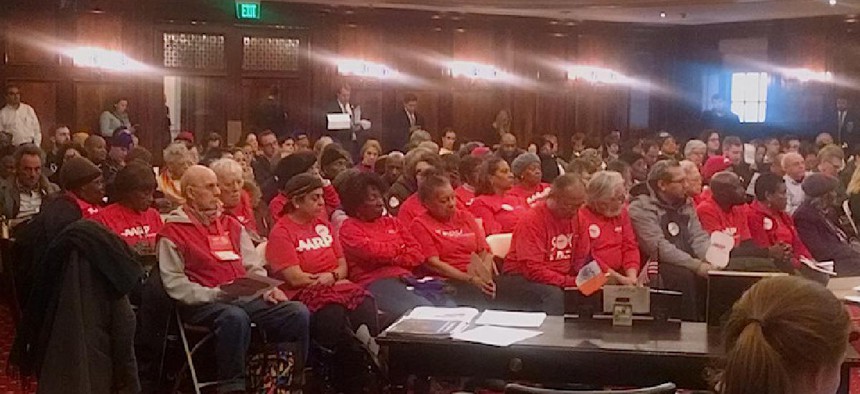A sea of senior citizens in red AARP T-shirts packed into the New York City Council chambers Wednesday as de Blasio administration officials defended a major zoning proposal they said would help care for the city’s elderly during their final days.
The city’s Zoning for Quality and Affordability proposal would pave the way for the creation of senior housing across the city and mixed-income residences near transit – as well as housing these projects in buildings that better blend in with their surroundings, Department of City Planning Director Carl Weisbrod said.
“ZQA is based on the premise that housing affordability does not need to be sacrificed to achieve design quality, nor vice versa,” Weisbrod said. “There are several ways in which today’s zoning rules hamper our ability to create affordable housing, making us pay more to get less and making it difficult to build residential buildings that contribute to the fabric of our neighborhoods.”
The Council has until late March to vote on ZQA as well as its Mandatory Inclusionary Housing proposal, which would allow larger buildings in rezoned neighborhoods as long as any new developments include a certain number of affordable units. The administration has described the two measures as a critical part of its broader affordable housing strategy.
Still, Council members expressed concerns about permitting taller buildings and the reduction or elimination of the number of parking spaces that developments currently must include. City Councilman Vincent Gentile said he represents low-density, multi-family communities where ZQA could introduce four- to six-story senior homes. Gentile said he did not question that this would benefit seniors, but he was unsure whether the zoning code would protect the communities’ character.
Department of Housing Preservation and Department Commissioner Vicki Been said ZQA struck a balance between ensuring seniors had access to a building with an elevator and building residences that contrast with the existing surroundings. She said the city has a seven-year waiting list for low-income senior housing. Meanwhile the city’s senior population, of which 20 percent is in poverty, is expected to grow 40 percent by 2040.
“We are faced with a crisis of providing housing for our seniors, and it is very hard to say to a senior who is facing being homeless or not knowing where they are going to spend their final years, ‘Oh, I’m sorry we can’t provide housing because, you know, people are concerned about height,’” Been said.
ZQA would no longer require parking spaces to be included for senior housing within a half-mile of subway stations or deemed to be in transit zones because of their proximity to other transit links or commercial and medical facilities. But Council members questioned the designation of some of these zones, saying they were not actually well served by transit.
The administration, when pressed, agreed to consider an approval process for cutting back on the required number of parking spaces. City housing officials, however, stressed that research shows very few people living in subsidized housing own cars. The $50,000 cost of a parking space often means each slot equates to the loss of a subsidy for 1.5 senior housing units, they said.
Although Council members said they supported new housing for the elderly, some were not as welcoming of other aspects of ZQA. Under the current plan, parking requirements would also be removed for mixed-income developments near transit zones. The measure would also increase height limits up to two stories, in most cases, and allow for greater architectural diversity.
Councilman Antonio Reynoso said his entire district was mapped into a transit zone under de Blasio’s affordable housing program, despite Williamsburg growing rapidly in the wake of a recent rezoning.
“You can’t win the parking argument when hundreds of thousands of new residents are coming into the neighborhood and the transportation infrastructure that we currently have is unchanged,” Reynoso said. “This is an argument that I am trying to win in my district. ... I really need you to help me to help you.”
Been and Weisbrod responded to Reynoso’s concerns about inadequate transit funding by saying the administration had committed an “unprecedented” amount of money to the MTA capital plan. But they also agreed to discuss the designation with Reynoso.
Although some Council members have expressed concerns that commitments could fall by the wayside under future administrations, it is unlikely that any new proposals to create an enforcement mechanism could be drafted and considered at a public hearing in time to be voted on alongside the two zoning measures.
Land Use Committee Chairman David Greenfield said his colleagues generally seemed supportive of ZQA aspects that promote affordability, but how the “quality” aspects – such as higher ceilings and other more flexible architectural features – are viewed seemed much more subjective. He said the biggest point of conversation when it came to MIH was whether it targeted enough families with very low incomes. The councilman said he is discussing both measures with the administration daily and, due to the breadth of the legislative text, hopes any amendment agreements can be reached soon.
“If you’re going to make changes, you want to start working on the changes as soon as possible,” he said.


